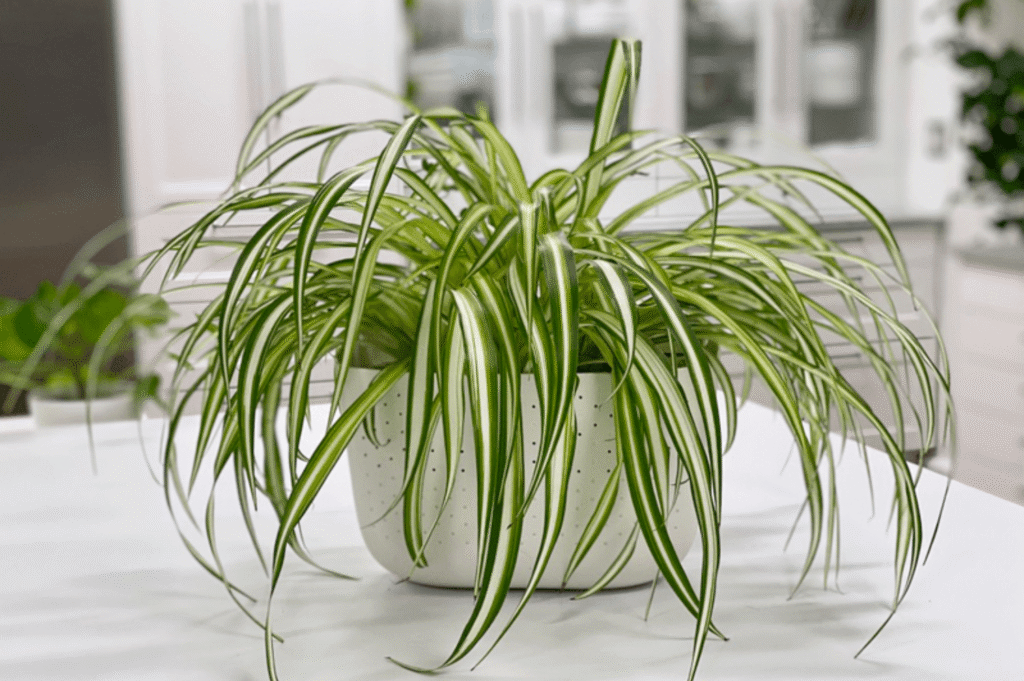Spider plants (Chlorophytum comosum) are popular houseplants because they are hardy, beautiful, and easy to care for. But sometimes, you may notice that your spider plant seems stuck. It’s not producing new leaves, runners, or growth. If this happens, it’s a sign that something in its environment is not right.
In this article, we’ll explore the common reasons why your spider plant might not be growing and how you can fix it quickly.
What Are the Common Reasons Spider Plants Stop Growing?
There are several reasons why a spider plant might slow down or completely stop growing:
- Lack of proper light – Too little or too much sunlight can stress the plant.
- Overwatering or underwatering – Watering issues can damage the roots.
- Poor soil quality – Old, compacted, or nutrient-deficient soil affects growth.
- Lack of fertilizer – Spider plants need feeding during the growing season.
- Temperature stress – Extreme heat or cold can cause growth to stall.
- Rootbound conditions – If the roots have no space to expand, growth slows down.
Understanding the root cause is the first step to reviving your plant.
Is Your Spider Plant Getting Enough Light?
Light is one of the most important factors for spider plant growth.
- Spider plants prefer bright, indirect sunlight. Direct sun can scorch their leaves, while low light can result in weak, slow growth.
- Place your plant near an east- or north-facing window where it gets plenty of natural light but not harsh rays.
- If you don’t have good natural light, consider using LED grow lights for at least 10–12 hours a day.
Tip: If the leaves look pale or are stretching towards the light source, it’s a sign your plant needs more light.
Can Overwatering or Underwatering Slow Growth?
Yes, incorrect watering is one of the top reasons spider plants stop growing.
- Overwatering leads to root rot, which damages the plant’s ability to absorb nutrients. Signs include yellowing leaves, mushy roots, and a foul smell.
- Underwatering causes the plant to dry out, leading to crispy brown tips and stunted growth.
Best Watering Practices:
- Water your spider plant when the top 1–2 inches of soil feel dry.
- Make sure the pot has drainage holes to prevent waterlogging.
- Use room-temperature water, as cold water can shock the roots.
Pro Tip: During winter, reduce watering frequency because the plant’s growth naturally slows down.
Does Soil Quality Affect Spider Plant Growth?
Absolutely! Poor soil is another major reason spider plants fail to thrive.
- Spider plants prefer loose, well-draining soil.
- Heavy or compacted soil holds too much water, leading to root problems.
- Old soil can become nutrient-depleted, leaving your plant hungry.
How to Fix It:
- Repot your spider plant every 12–18 months with fresh potting mix.
- Use a high-quality indoor plant mix that contains perlite or peat moss for better drainage.
- Check the roots while repotting, if they are tightly wound, gently loosen them to encourage new growth.
When Should You Fertilize a Slow-Growing Spider Plant?
Lack of nutrients can cause slow or no growth.
- Feed your spider plant with a balanced liquid fertilizer (10-10-10 or 20-20-20) every 2–4 weeks during the spring and summer.
- Avoid fertilizing during winter because the plant is in a dormant phase.
- Over-fertilizing can burn the roots and damage the plant, so always follow the instructions on the label.
Quick Fix: If you suspect nutrient deficiency, use a water-soluble fertilizer at half-strength and observe for new growth within a few weeks.
How to Revive a Stunted Spider Plant Effectively
If your spider plant has already stopped growing, here’s how you can bring it back to life:
- Check the roots – Remove the plant from the pot and inspect for root rot or compacted roots. Trim damaged roots and repot if necessary.
- Adjust watering – Follow a consistent watering schedule and ensure proper drainage.
- Improve lighting – Move the plant to a brighter spot or use grow lights.
- Refresh the soil – Use fresh, nutrient-rich potting mix.
- Fertilize correctly – Feed the plant during its active growing season.
- Maintain ideal temperature – Keep your spider plant in a stable environment (60–80°F or 15–27°C).
- Prune damaged leaves – Cut off yellow or dead leaves to encourage new growth.
Bonus Tip: If your spider plant is rootbound and extremely crowded, divide it into two or more plants during repotting. This gives each plant more room to grow.
Final Thoughts
A spider plant that isn’t growing is sending you a clear signal: something is wrong in its environment. By checking light, watering, soil quality, and nutrients, you can quickly identify the problem and fix it. With a little care and attention, your spider plant will bounce back and start producing lush, healthy leaves and plantlets again.
Remember: Patience is key. Spider plants can take a few weeks to recover after you make changes. Keep monitoring their progress, and soon you’ll see the results.





